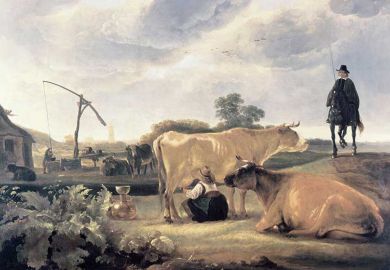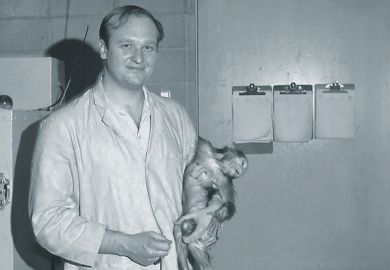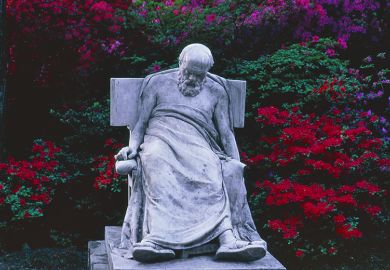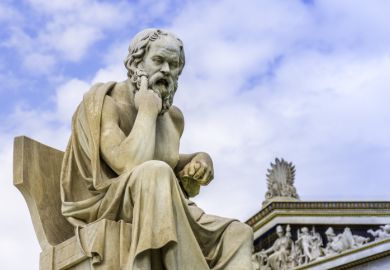If there were ever a war between cats and academic philosophers, John Gray would be on the side of the cats. As a Wittgensteinian at the service of four felines, I can’t help but sympathise. Gray’s quip that contemporary philosophy “is the practice of elucidating the prejudices of middle-class academics” may strike its targets as an uncharitable generalisation, but there is more truth to the caricature than we would like to admit.
One problem with philosophers throughout the history of the subject is that they have all been human. Indeed, Gray’s book is not so much a defence of cats as an attack on humans: those “wretched” and “self-divided” creatures that cannot bear their own company and whose lives are largely spent in “displacement activity”.
Riffing on thoughts from the early modern French philosophers Blaise Pascal and Michel de Montaigne, Gray suggests that human beings turn to philosophy to divert themselves from their miserable condition of “inner anguish”, ultimately caused by the knowledge that they must one day die. Cats, by contrast, we are told, have not “formed an image of themselves” and therefore “do not need to divert themselves from the fact they will someday cease to exist”.
The author accordingly characterises our purported need for distraction, diversion and digression as a “uniquely human trait” that arises by way of response to what he sees as “the defining feature of the human animal”, namely “the fear of death that comes with self-awareness”. It’s true that one can sometimes see various everyday activities as a distraction from thinking about death. But it is equally possible to view the preoccupation with one’s own death as a distraction from the ebb and flow of everyday life. Neither approach is very satisfying, but it is the latter that best fits alongside the other feline cards Gray uses against humanity: if humans were more cat-like, they could navigate the world without ever becoming distracted by the anxious thought that they must one day die.
Gray’s anti-humanism is not of the post-humanist variety that challenges the very idea of a sharp distinction between humans and animals. Humans stand out all right, but Gray sides with Montaigne over Pascal in thinking that the ways in which they do are not a good look. Here, he gives the game away that this is not really a book about cats at all. Indeed, there are very few comparisons with other animals and most of the time he could have replaced “cat” with any other animal and his point would still stand. “Much of philosophy consists in the worship of linguistic fictions. Relying on what they can touch, smell and see, cats are not ruled by words”: this and other similar passages might have come straight out of Mark Rowlands’ The Philosopher and the Wolf: Lessons from the Wild on Love, Death and Happiness (2008), in which its author writes: “We see through moments and for that reason the moment escapes us. A wolf sees the moment but cannot see through it. Time’s arrow escapes him. That is the difference between us and wolves. We relate to time in a different way. We are temporal creatures in a way that wolves and dogs are not.”
Like Rowlands before him, Gray thinks that humans are constitutionally unable to live in the moment for more than a few fleeting seconds. But whereas Rowlands concludes from this that there is no meaning of life, Gray ends his book (spoiler alert) with the assertion that “the meaning of life is a touch, a scent, which comes by chance and is gone before you know it”. On the surface, this feels like the prose equivalent of the pretentious plastic bag ending of Sam Mendes’ 1999 film, American Beauty. But the movie scene is narrated by a human who speaks of the bag as proof of “this incredibly benevolent force”, concluding that “sometimes there’s so much beauty in the world, I feel like I can’t take it”. Animals, by contrast, experience the world without ideology. But why think that it is the meaning of life to do so? Why even think that there is such a thing as the meaning of life at all?
The book is surprisingly light on cat specifics. There is much more on what differentiates humans from our fellow creatures than about any properties that make cats stand out from the rest of the animal kingdom. Gray’s attempts to provide detail of traits that are feline, all too feline, are not always successful. Given that he has lived with cats for most of his life, it is surprising to find him claiming that they lack self-awareness, feel no anxiety and do not struggle to be happy. What we are ultimately left with is a book about how lousy humans are. This is not new territory for Gray, whose distrust of humanist ideologies has previously been aired in books such as Straw Dogs: Thoughts on Humans and Other Animals (2002) and The Silence of Animals: On Progress and Other Modern Myths (2013). The difference is that it is here interlaced with a potted history of ideas concerning cats (caveat emptor: if you are looking for a gift, make sure that the intended recipient is as interested in reading about “civilization as death-denial” as they are about “cats as dogs”.
While Feline Philosophy puts forth a clear thesis, Gray is not engaged in the academic pursuit of defending it against all objections. The resulting jargon-free prose is thus allowed to flow without the qualifications imposed on academics that can make their work unreadable. While it would be unfair to chastise Gray for not offering a tighter argument, it is nonetheless disappointing that he misreads a number of the philosophers he discusses in passing. For example, we are told that Wittgenstein thought that “ordinary language is littered with residues of past metaphysical systems” that describe “fictions”. This couldn’t be further from the truth. Had he done his homework, Gray would have discovered that central to Wittgenstein’s philosophy is the thought that, whatever the etymology of any given word or phrase, the everyday use of terms harbours no metaphysical commitments whatsoever.
The book concludes with 10 “feline hints on how to live well”. These consist of motivational quotes such as “do not look for meaning in your suffering”, “beware of anyone who offers to make you happy”, “sleep for the joy of sleeping” and “forget about pursuing happiness, and you may find it”. Cats clearly do not believe in or follow such rules, it is just that their behaviour, like that of most other animals, accords with them. Ultimately, Gray’s view cannot be that cats are better philosophers than humans. Although he never quite states it explicitly, the true lesson of the book is that cats are better than us precisely because, despite the book’s title, there can be no such thing as feline philosophy.
Constantine Sandis is professor of philosophy at the University of Hertfordshire. He is writing a book on Wittgenstein’s lion for Bloomsbury.
Feline Philosophy: Cats and the Meaning of Life
By John Gray
Allen Lane, 128pp, £20.00
ISBN 9780241351147
Published 29 October 2020
The author
John Gray, one of the UK’s leading political thinkers, was born in South Shields, County Durham, and studied philosophy, politics and economics at Exeter College, Oxford. He taught at the University of Essex, Oxford and Bowling Green State University in Ohio, with visiting professorships at Harvard and Yale, before becoming professor of European thought at the London School of Economics.
He is the author of Two Faces of Liberalism (2000) as well as scholarly studies of Voltaire, John Stuart Mill, Isaiah Berlin and Friedrich von Hayek.
Increasingly interested in addressing a less specialist readership, however, Gray challenged the triumphalism that greeted the fall of the Soviet Union in many Western countries in False Dawn: The Delusions of Global Capitalism (1998). He left the academy in 2008 to become a full-time writer and has since produced a series of provocative books including The Immortalization Commission: Science and the Strange Quest to Cheat Death (2011), The Silence of Animals: On Progress and Other Modern Myths (2013), The Soul of the Marionette: A Short Inquiry into Human Freedom (2015) and Seven Types of Atheism (2018).
A sceptic about humanism, progress and many of the ideals of the Enlightenment, and the ability of secular ideologies to go beyond religious ways of thinking, Gray once argued that the best achievable version of “the good life” consisted in “seeking peace – without hoping for a world without war. It means cherishing freedom – in the knowledge that it’s an interval between anarchy and tyranny.” But although statements such as this have given him something of a reputation as a pessimist, he once told Times Higher Education that “Accepting that we are flawed and our problems not fully soluble need not be paralysing; it could make us more flexible and resourceful.”
Matthew Reisz
POSTSCRIPT:
Print headline: Feline free, livin’ in the moment
Register to continue
Why register?
- Registration is free and only takes a moment
- Once registered, you can read 3 articles a month
- Sign up for our newsletter
Subscribe
Or subscribe for unlimited access to:
- Unlimited access to news, views, insights & reviews
- Digital editions
- Digital access to THE’s university and college rankings analysis
Already registered or a current subscriber?








